Out of the Darkness - A Holocaust Remembrance Exhibition
On view by appointment at the Lisanby Museum until the end of April 2022
NewsSUMMARY: This exhibition is presented in honor of International Holocaust Remembrance Day (January 27), when the world remembers the devastating loss of six million Jewish men, women, and children and vows with one voice: never again. The Holocaust was the systematic state-sponsored killing of Jews as well as Sinti-Roma, Slavs, disabled people, members of the LGBTQ+ community, and others by Nazi Germany and its collaborators. This attempted genocide resulted in the murder of roughly two-thirds of Europe’s Jewish population between from 1941 to 1945. With the support of the Holocaust Remembrance Day Planning Committee, the Lisanby Museum presents the works of Ben Shahn and Marc Chagall, who commemorated and celebrated their Jewish culture through art. We invite you to examine the Hebrew lettering and religious themes in Shahn’s activist artwork, and the bright, colorful abstraction of Hasidic life in Chagall’s paintings. As you walk through this space, take your time to contemplate the images, reflect on their deeper meanings, and witness how these artists processed the tragedies of the Holocaust and gave voice to the millions who were silenced.
 Ben Shahn (Lithuanian born American, 1898-1969)
Ben Shahn (Lithuanian born American, 1898-1969)
Menorah (incomplete frontispiece for Haggadah for Passover, 1965)
1966
Lithograph in color
58.5 x 36 cm
Gift of Ben Shahn Estate, 2015
MAC, 2021.3.47
Menorahs are multibranched candelabras used in Jewish religious rituals. First mentioned in the Book of Exodus, these lamps have seven candles to symbolize the seven days of Creation, and their shape resembles the Tree of Life. Menorahs can also be considered symbols of loss, as the menorah of the Second Temple of Jerusalem was looted by the Romans in 70 CE. Today it is also a popular symbol of Judaism and Jewish pride. In other versions of this artwork, Shahn included the Shehecheyanu, a prayer traditionally recited in Judaism to celebrate new, joyful experiences:
בָּרוּךְ אַתָּה יְי אֱלֹהֵינוּ מֶלֶךְ הַעוֹלָם שֶׁהֶחֱיָנוּ וְקִיְּמָנו וְהִגִּיעָנוּ לַזְּמַן הַזֶּה
Blessed art thou Lord our God, King of the universe, who hast granted us life and sustenance and permitted us to reach this occasion.
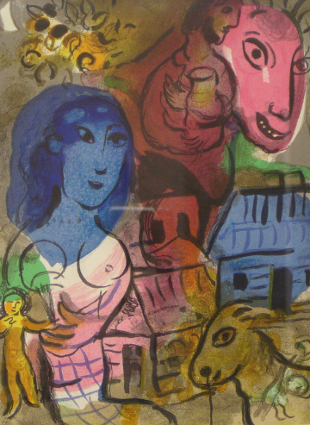 Marc Chagall (Russian born French, 1887-1985)
Marc Chagall (Russian born French, 1887-1985)
L’Amour De La Nature/Homage à Marc Chagall
1969
Lithograph
53 x 38.1 cm
MAC, 80.4.5
In this painting, Marc Chagall captures life in the small Hasidic community where he grew up in Russia. After a series of pogroms—violent, state-sanctioned attacks targeting Jewish businesses and homes—Chagall was forced to flee to Paris, where he began creating artwork centered on his memories and culture. These included images from his childhood and scenes from the Tanakh (Hebrew Bible). Goats and chickens, both emblematic of Chagall’s village, feature frequently in his work. Here, his dreamlike abstraction combines Earth, man, and biblical scenes to show the sacred nature of Jewish culture and commemorate a lost way of life.
When World War II began in 1939, Chagall immigrated to the United States with the help of the Museum of Modern Art (MoMA). He was one of several Jewish artists the museum helped to escape Nazi persecution. To learn more, click the following link:
https://www.moma.org/explore/inside_out/2016/06/22/in-search-of-momas-lost-history-uncovering-efforts-to-rescue-artists-and-their-patrons/
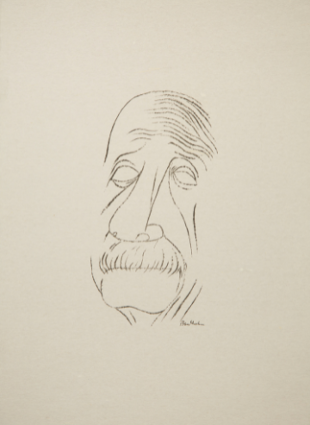 Ben Shahn (Lithuanian born American, 1898-1969)
Ben Shahn (Lithuanian born American, 1898-1969)
Einstein
1950
Photo-offset in black
58.5 x 46 x 3 cm
Gift of Ben Shahn Estate, 2015
MAC, 2021.2.73
Famed theoretical physicist Albert Einstein (1879 – 1955) was one of many Jewish scientists who emigrated from Germany after Adolph Hitler’s rise to power in 1933. Einstein was an outspoken critic of the new Nazi government and resigned in protest from the Prussian Academy of Sciences in Berlin before fleeing to Belgium. In Germany, his publications were burned, with one newspaper offering a bounty on his head. Einstein eventually settled in Princeton, New Jersey, close to Shahn’s hometown, where he continued his work and advocated for aid and acceptance of Jewish refugees. This image was used to illustrate Einstein’s article, “On the Generalized Theory of Gravitation,” in the April 1950 issue of Scientific American.
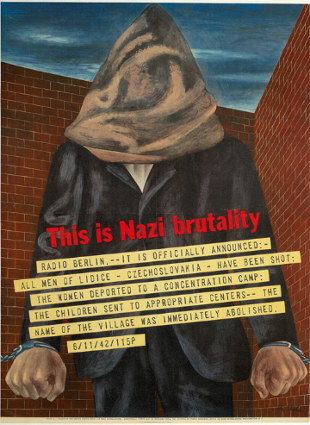 Ben Shahn (Lithuanian born American, 1898-1969)
Ben Shahn (Lithuanian born American, 1898-1969)
This Is Nazi Brutality
1942
Offset photolithograph in color
122 x 98.4 x 3.8 cm
Gift of Michael Berg, 2013
MAC, 2018.3.4
Shahn began designing posters for the U.S. government as a Resettlement Administration artist during the Great Depression, and his work continued into World War II with the Office of War Information. In this poster, he confronts the viewer with the horror of Nazi Germany’s massacre of the village of Lidice on June 11, 1942, in retaliation for the assassination of a SS officer by Czech resistance fighters. A single trapped, chained, and hooded figure represents the victims, which included 192 men, 60 women, and 88 children Ultimately, distribution of the poster was blocked by a civilian moral expert on the grounds that the image was too disturbing.
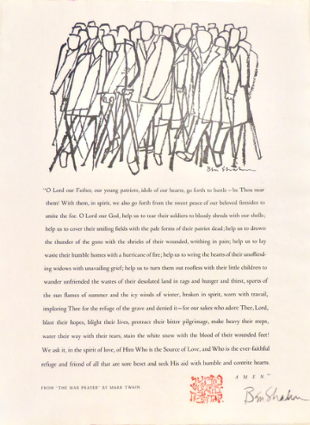 Ben Shahn (Lithuanian born American, 1898-1969)
Ben Shahn (Lithuanian born American, 1898-1969)
O Lord Our Father (War Prayer by Mark Twain)
1964
Letterpress in black on machine-made paper
56.5 x 42.5 cm
Gift of Ben Shahn Estate, 2015
MAC, 2021.4.101
This prayer comes from a satirical short story written by celebrated author Mark Twain (1835-1910). The story tells of a stranger who enters a church service where the congregants are praying for victory in the war. The stranger addresses the room and warns how with victory comes the destruction of the enemy and loss of human life. His efforts prove to be in vain, as the congregants dismiss him as a lunatic. Shahn paired this prayer with a drawing of an endless crowd of faceless figures, many of whom are supported by crutches and canes. This nameless crowd represents the pain and suffering caused by war and harkens to images of Jewish people forced from their homes into ghettos and concentration camps.
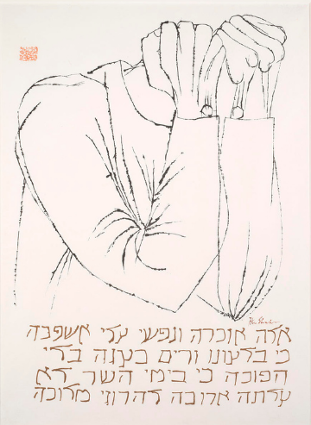 Ben Shahn (Lithuanian born American, 1898-1969)
Ben Shahn (Lithuanian born American, 1898-1969)
Warsaw, 1943
United States
1963
Screen print in black and brown on Japon paper
111.76 x 88.9 x 3.81 cm
Gift of Michael Berg, 2016
MAC, 2016.1.2
Racism and anti-Semitism formed the basis of Nazi ideology, with Jews and other minorities referred to as Untermensch (subhuman). Although harsh, anti-Jewish restrictions began much earlier, beginning in 1939, Jews in Nazi-occupied areas of Europe were forced from their homes and confined in ghettos—overcrowded areas where many died from disease and starvation. The Warsaw Ghetto in Poland was the largest, with 460,000 people crammed into just over a square mile of land. In 1943, inhabitants led an uprising, the largest single revolt by Jews during World War II. Over 13,000 people died during the uprising, with nearly all survivors deported to the Treblinka extermination camp. Here, Shahn commemorates the destruction with a single figure whose face is hidden behind clenched fists. Below the figure is text recited on Yom Kippur and Tisha B’av, which translates as: “These martyrs I will remember, and my soul is torn with sorrow. In the days of our trials, there is no one to help us."
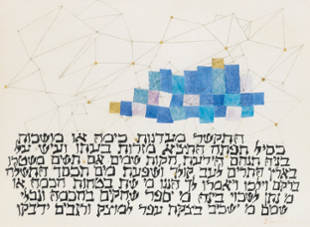 Ben Shahn (Lithuanian born American, 1898-1969)
Ben Shahn (Lithuanian born American, 1898-1969)
Pleiades, dedicated to Moishe Bressler
1960
Serigraph, printed in gray and black, with hand coloring
50.8 x 67.3 x 3.2 cm
Gift of Analisa Berg, 2019
MAC, 2021.2.93
Here Ben Shahn presents his interpretation of the Pleiades star cluster. Below the constellation is an excerpt from the Book of Job, thought to be the oldest book in the Tanakh (Hebrew Bible). It tells the story of Job, a good man who endures extreme suffering but ultimately maintains his faith in God. The connection between the Book of Job and the constellation comes from a section where God poses a series of profound questions dealing with man’s limited knowledge, including: “Can you bind the chains of the Pleiades or loose the cords of Orion?" The central tenet of the story, that some suffering is the result of unfathomable conflicts between the power of light and the power of darkness, would have had a special poignancy to those who suffered during the Holocaust.
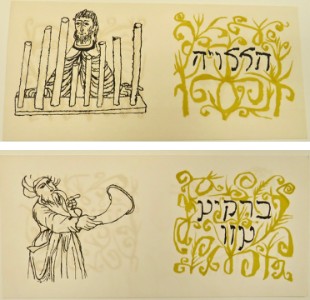 Ben Shahn (Lithuanian born American, 1898-1969)
Ben Shahn (Lithuanian born American, 1898-1969)
Hallelujah Miniatures No.1 with Calligraphy, posthumous edition
1970-71
Lithographs
39 x 18 cm each
Gift of Ben Shahn Estate, 2015
MAC, 2021.3.51 A-M
Despite the enormous loss of life caused by Nazi leaders and their collaborators, the planned genocide of European Jews failed. Today, more than 14 million Jewish people live in dozens of countries around the world, with the largest populations in the United States and Israel. This suite of unbound lithographs illustrates the triumphal Psalm 150, the last psalm in the Book of Psalms. The text translates as:
Hallelujah, hallelujah!
Praise God in his sanctuary,
Praise Him in the firmament of his power,
Praise Him for his mighty acts,
Praise Him according to his abundant greatness,
Praise Him with the blast of the trumpet,
Praise Him with the psaltery and harp,
Praise Him with the timbrel and dance,
Praise Him with stringed instruments and the pipe,
Praise Him with the loud-sounding cymbals,
Praise Him with the clanging cymbals,
Let everything that hath breath praise the Lord,
Hallelujah!
Extra:
To listen to this psalm performed by MIQEDEM, click here:
https://miqedem.bandcamp.com/track/psalm-150-at-home-across-the-globe-single
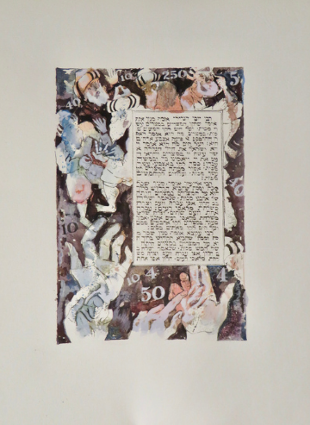
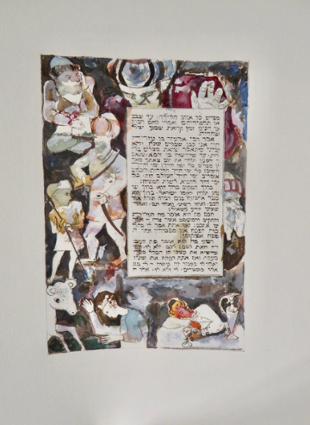
Ben Shahn (Lithuanian born American, 1898-1969)
Print for Haggadah for Passover
1966
Collotype and pochoir plates after original watercolors
40 x 35 cm
Gift of Michael Berg, 2015
MAC, 2021.3.52 A-D
Inspired by Medieval illuminated Hebrew manuscripts and his encounters with the Jews of Djerba in North Africa, Shahn created this illustrated version of the Haggadah, which is recited on the first two nights of Passover. Passover commemorates the Jewish struggle against oppression; for the Jews of Europe, their struggle did not end with the Allied defeat of Nazi Germany in 1945. Survivors experienced not only lasting physical and mental trauma, but the daunting task of rebuilding their lives with few financial resources and familial connections. Many emigrated from Europe, facing new cultures, language barriers, and even those who denied the existence of the Holocaust.
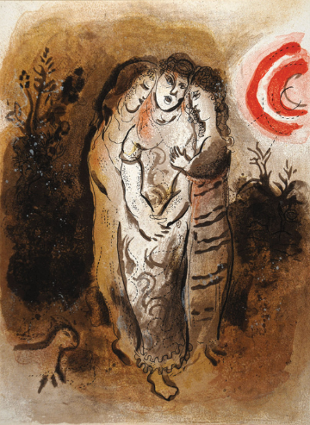 Marc Chagall (Russian born French, 1887-1985)
Marc Chagall (Russian born French, 1887-1985)
Naomi and her Daughters-In-Law
1960
Lithograph in color
61 x 51 x 5 cm
MAC, 2021.4.38
In this print, Chagall depicts a moment from the Book of Ruth in the Hebrew Bible. Following the deaths of her husband and two sons, Naomi, depicted at center, embraces her daughters-in-law Orpah and Ruth. Chagall used dark colors for their surroundings that seem to close in around them. However, the figures themselves appear clear and bright, symbolizing their bond which shines through their hardships. Ruth ultimately decides to remain with Naomi, saying, “Where you go, I will go; where you lodge, I will lodge; your people shall be my people, and your God my God. Where you die, I will die—there will I be buried.”
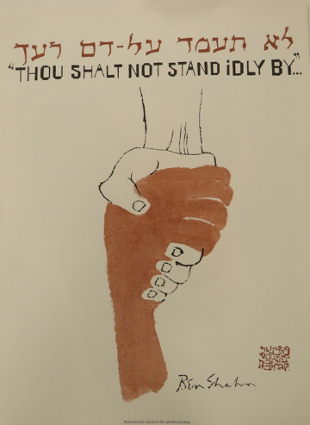 Ben Shahn (Lithuanian born American, 1898-1969)
Ben Shahn (Lithuanian born American, 1898-1969)
Thou Shalt Not Stand Idly By
1983
Reproduction poster from 1966 first printing
38.5 x 49.5 cm
Gift of Ben Shahn Estate 2018
MAC, 2021.4.160
Shahn developed this work to showcase racial unity in America while also presenting viewers with a call to action against injustice rather than standing “idly by.” The quote is from the Book of Leviticus 19:16, which encourages neighbors to stand together against violence. Shahn was a passionate supporter of religious freedom and human rights, stating in 1944, “I hate injustice. I guess that’s the only thing I really do hate.”
Please note that this image reflects the values of a mid-twentieth century artist and should be seen in that context.
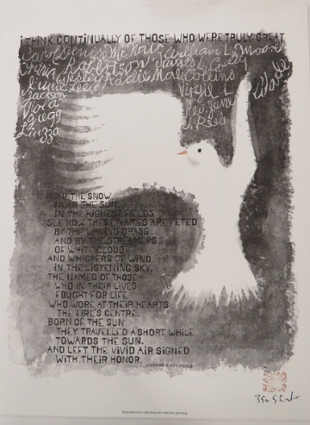 Ben Shahn (Lithuanian born American, 1898-1969)
Ben Shahn (Lithuanian born American, 1898-1969)
I Think Continually of Those Who Were Truly Great
1983
Reproduction poster from 1966 first printing
38.5 x 49.5 cm
Gift of Ben Shahn Estate, 2018
MAC, 2021.4.159
Jewish activists took part in numerous activities of the American civil rights movement, sympathizing with and relating to the oppression faced by Black people. Shahn created this print as a tribute to the heroes and martyrs of the movement, whose names are recorded in white. This includes the names of four Black girls killed in a bomb blast at the Sixteenth Baptist Church. Just one year before this poster’s completion, Rabbi Abraham Joshua Heschel (Polish-born American, 1907 – 1972), whose mother and three sisters were killed during the Holocaust, marched arm-in-arm with Dr. Martin Luther King Jr (1929 –1968) on the front line of the third Selma Civil Rights March. The image of the two leaders standing together immortalized their shared fight against religious intolerance and racism, a fight that continues to unite many in the Black and Jewish American communities to this day.
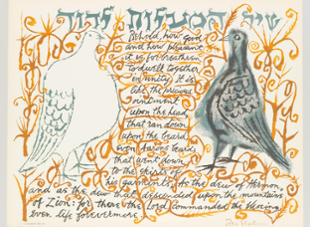 Ben Shahn (Lithuanian Born American, 1898-1969)
Ben Shahn (Lithuanian Born American, 1898-1969)
Psalm 133
1960
Screen print in color
53 x 67.9 cm
Gift of Michael Berg 2021
MAC, 2021.4.178
In this print, Shahn commemorates the message of brotherly love by framing Psalm 133 with two doves, symbols of peace in Judaism. The English text contains the words of the psalm, including: “How good and how pleasant it is for brethren to dwell together in unity!”
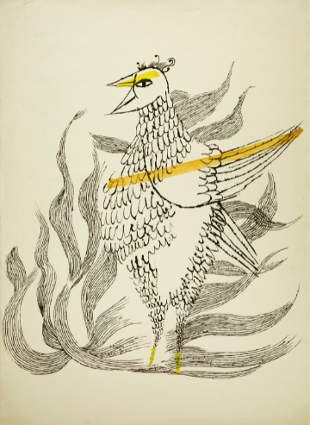 Ben Shahn (Lithuanian born American, 1898-1969)
Ben Shahn (Lithuanian born American, 1898-1969)
Phoenix
1952
Screen print in black with hand coloring, incomplete
90.2 x 73 x 3.2 cm
Gift of Ben Shahn Estate 2015
MAC, 2021.2.67
This incomplete screen print shows a phoenix, a mythological creature that, after death, rises from the ashes of its funeral pyre to begin its life cycle anew. The symbol is a poignant reminder of how the Jews of Europe rose from the ashes of the Holocaust to rebuild their cultures and communities and to fight for justice against oppression. After the Allied defeat of Nazi Germany in 1945, Holocaust survivors helped spread knowledge of the atrocities worldwide. Their tireless efforts helped support the passing of the Genocide Convention by the United Nations, an instrument of international law that codified and condemned the crime of genocide. Its adoption marked a crucial step towards the development of international human rights and international criminal law, as we know it today.
International Holocaust Remembrance Day is honored annually on January 27, the date that the Auschwitz concentration camp was liberated. The day is intended to not only honor the victims of the Holocaust but to renew a commitment to Holocaust education and human rights across the globe.

